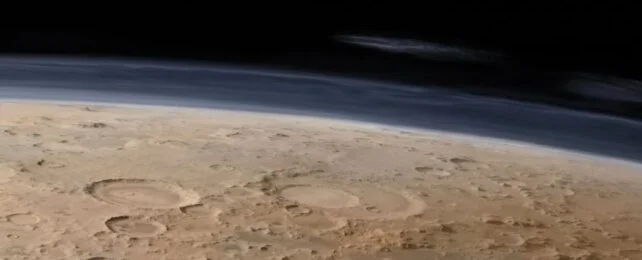
MAVEN Confirms Atmospheric Sputtering on Mars: Key to Understanding Water Loss
Scientists have achieved a groundbreaking milestone in understanding Mars' atmospheric evolution. NASA's MAVEN (Mars Atmosphere Volatile Evolution) mission has made the first direct observation of atmospheric sputtering, a process long suspected of playing a crucial role in the planet's transition from a potentially habitable world to the cold, dry desert it is today.
This discovery, published in Science Advances, provides critical evidence for how Mars lost its atmosphere and, consequently, its surface water. The key process at play is atmospheric sputtering, where ions from the solar wind essentially knock atmospheric particles into space. Given Mars’ lack of a planet-wide magnetic field, its atmosphere is vulnerable to this phenomenon.

As Shannon Curry, principal investigator of MAVEN at the Laboratory for Atmospheric and Space Physics at the University of Colorado Boulder, aptly describes it, “It’s like doing a cannonball in a pool. The cannonball, in this case, is the heavy ions crashing into the atmosphere really fast and splashing neutral atoms and molecules out.”
Previously, scientists had only indirect evidence of sputtering, primarily through the observation of lighter and heavier argon isotopes in the upper Martian atmosphere. The MAVEN mission's direct observation, however, represents a significant leap forward. By simultaneously using data from the Solar Wind Ion Analyzer, the Magnetometer, and the Neutral Gas and Ion Mass Spectrometer aboard MAVEN, researchers were able to map sputtered argon relative to the solar wind.
The team found that the rate of sputtering is four times higher than previously predicted, and it increases during solar storms. This finding strongly supports the theory that sputtering substantially contributed to the loss of Mars' early atmosphere, especially when solar activity was much more intense.
The implication of this discovery extends to understanding the potential for past habitability on Mars. With a thicker atmosphere, liquid water could have existed on the surface for extended periods. Studying sputtering helps piece together the puzzle of why Mars changed so dramatically.
These findings have resulted from analyzing nine years' worth of satellite data, data that further indicates that atmospheric sputtering has been ongoing for an extended period, largely backing up theories that point to the loss of water on the surface and in the atmosphere of Mars.
The research highlights the importance of long-term space missions like MAVEN in unraveling the mysteries of planetary evolution. By directly observing fundamental processes like atmospheric sputtering, we gain valuable insights into the past, present, and possibly even the future of our solar system.
What are the implications of this discovery for future Mars missions? How might this information impact our search for evidence of past or present life on the Red Planet? Share your thoughts in the comments below!